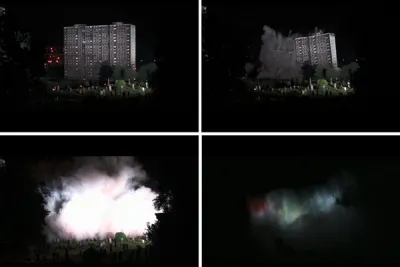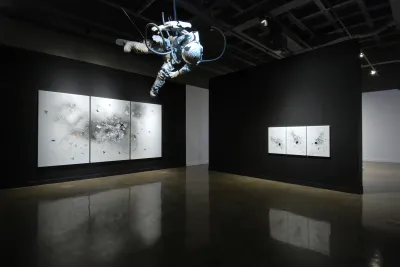Cyprien Gaillard, Pruitt Igoe Falls 2009 (video still), courtesy the artist and Sprüth Magers Berlin London.
Cyprien Gaillard: Pruitt-Igoe Falls

On the afternoon of March 16, 1972, at approximately 3:00PM, a series of small explosions flashed from inside an eleven-story high rise apartment building on the north side of St. Louis, Missouri.
The ensuing shock wave caused the building to shudder momentarily before it collapsed in on itself and a great plume of dust rushed upward and out. Following years of decay, crime, and governmental neglect, the detonation heralded not only the physical demolition of the whole 57-acre Pruitt-Igoe public housing project; the project’s destruction came to stand as a signifier of the failure of modern architecture to house the poor in livable environments. Cyprien Gaillard’s Pruitt-Igoe Falls revisits this symbolic death while leveraging artists’ historical treatments of the Sublime, or past efforts to stir an emotional response in viewers through the depiction of vast, irregular, and superhuman subjects.
Pruitt-Igoe Falls does not employ footage of the eponymous project’s implosion; rather, Gaillard utilizes video from the controlled demolition of a tower block apartment at 2:30AM, July 13, 2008, in Glasgow, Scotland. As the building collapses, the concomitant dust cloud spreads to cover where the structure once stood and conceals the light emanating from off-camera. This leaves the scene in near blackness before a glow languidly re-illuminates the screen. Only, as the video continues, the emphemeral nebula containing the airborne remnants of the building transform into the monumental downrush of Niagara Falls.
Gaillard’s choice of subject matter reactivates Western representational traditions of the 18th and 19th century that address the Sublime through subjects such as architectural ruins, topographical extremes, and disastrous events. This effect is distinctly compounded by Gaillard’s choice of lighting, which creates sharp contrasts so that a scene with a carefully demarcated bright spot is set against a progressively darkening edge. This technique associates particularly with the paintings by Joseph Wright (1734-1797) of Vesuvius erupting after dark or building conflagrations at night. Pruitt-Igoe Falls also documents a rainbow of colors illuminating Niagara Falls. This footage records a tradition that was begun in 1860 of projecting colored lights on the waterfall at night, a tradition begun contemporaneously with the painting of various Romantic, color-washed landscapes of the Falls by Alvan Fisher (1792-1863).
Gaillard imparts key manipulations to such historical works. Whereas Fisher’s paintings often emphasize the Fall’s massive scale through the depiction of tiny tourists in the foreground, Gaillard films from a vantage point which effectively miniaturizes the apartment’s great size. This vantage point, the Sighthill Cemetery adjacent to the building, also imparts the illusion that gravestones abut the high rise. The headstones serve to signify how the death of architectural modernism is repeatedly re-enacted through the demolition of modernist buildings; they also gesture towards the loss of life associated with the fall of the World Trade Centers, as both Pruitt-Igoe and the Twin Towers were designed by the architect Minoru Yamasaki. The headstones further elicit the more intangible question of the affective impact of the destruction of housing on the families that once inhabited it.
The high rise detonated in Gaillard’s work was part of Fountainwell, a section of Sighthill public housing estate and home to hundreds of primarily Turkish, Kurdish, Iraqi, and Palestinian families seeking asylum. In the past ten years, Fountainwell has served as the site of a series of violent clashes between these asylum seekers and the local populace and is slated for wholesale demolition, “despite overwhelming pleas from residents for their homes to be kept.”(1) Gaillard, who grew up in tower block public housing in a Parisian suburb that has suffered considerable ethnically-motivated violence, refers to such demolitions as large scale state-sponsored vandalism. In other words, Gaillard invokes the practical eviction that occurs to families with the razing of modernist tower block housing and the concurrent violent eviction of personal and public memory.
Organized by Alise Upitis.
Cyprien Gaillard was born in 1980 in Paris, France, and graduated from ECAL, École cantonal d’art de Lausanne, Lausanne, France, in 2005. He has received solo exhibitions at venues such as Kunsthalle Fridericianum, Kassel, Germany; Hayward Gallery, London, U.K.; and MUSAC, Museo de Arte Contemporáneo de Castilla y Leon, Spain. He has also been included in group exhibitions at The New Museum, New York, NY; Generali Foundation, Vienna, Austria; SculptureCenter, New York, NY; Centre Pompidou, Paris, France; and was featured in the 5th Berlin Bienale. Gaillard lives and works in Paris, France.

